| The language of armory | Anatomy of the field | Charges: decoration and identification | The use of arms in gaming | Bibliography |
| Dragon | - | Estelmer |
- | Dragon 53 |
The term “heraldry” is widely used to
denote the study and use of coats of
arms to identify persons, families, or
organizations. The correct term for this is
“armory,” while “heraldry” properly refers
to all the duties of heralds. These
duties included record keeping (especially
of coats of arms), acting as messengers and negotiators, and organizing
events such as tournaments, coronations,
and celebrations. This article is
concerned only with armory and its application
to fantasy role-playing.
The origins of the use of coats of arms
are obscure. In ancient Israel and Rajput
India, badges were used to identify tribes
or people loyal to a prince. The seal
cylinders used in ancient Mesopotamia to
identify persons, American
Indian totems, and some flags are also distant
relatives of armory.
Only Japan and western Europe developed
true feudal systems, and only Japan developed something approaching
the complex European system of armory:
the “mon.” This heraldic badge was
never displayed large enough to be seen
at some distance, like a coat of arms
was
displayed on a shield, but it resembles
a
coat of arms in many respects: It was
used for decoration as well as identification,
it was displayed by troops and retainers as well as by the man entitled
to
bear it, and after several centuries of
use
the privilege to bear the mon was confined
to those legally registered with the
sovereign’s consent.
The purpose of the coat of arms was to
identify at a distance the man carrying
or
wearing the colors. During the Norman
conquest of England and the First Crusade
(both in the eleventh century) coats
of arms did not exist, though a few individuals
might bear an animal figure on a
shield. But as helms improved they covered
more of a man’s face, and armor
also obscured the wearer’s identity as
it
became more complex and covered more
of the wearer’s body. Moreover, the Crusaders,
speaking a dozen different languages and unfamiliar with their new
comrades, needed some simple means
of recognizing one another. It was not
enough to know a man’s nationality;
troops were loyal to individuals, not
to
nations.
Gradually, leaders began to adopt
simple colored patterns to display on
shields, surcoats, and flags to extricate
themselves and their followers from the
anonymity of full armor. Words or letters
would not have served, of course, in a
world of nearly universal illiteracy.
A
large display was necessary in a military
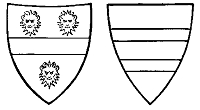
Left: arms of Michael de la Pole, Earl
of
Suffolk; azure, a fess between three
leopards’ faces or. Right: arms of William
Madault, Earl of Warwick; argent, two
bars gules. (See text for an explanation
of the descriptions.)
system dominated by armored cavalry,
for it was vital to know whether a man
was friend or foe before one charged.
Arms also served as patterns on seals
and signet rings. In some cases, such
as
the Great Seal of England, any document
not stamped with the proper seal
had no validity or force in law.
At first the patterns adopted were simple,
with ease of recognition uppermost
in mind. But as more knights adopted
arms, more elaborate patterns were
needed to avoid duplication. Nevertheless,
duplication could occur, on at least
one occasion requiring the personal intervention
of the King of England to determine who rightfully bore the arms.
It became evident that some record of
who was entitled to which arms would
help keep the peace. At this same time
(fourteenth century), sovereigns began
to grant arms to those deemed worthy,
and finally it became illegal to adopt
a
coat of arms without consent of the sovereign.
Military leaders usually adopted
or obtained coats of arms, and so the
holders of arms were usually nobility.
In parts of Europe, only those who
could prove that all 16 of their greatgreat-grandparents
were entitled to bear
arms (“seize quartiers”) could themselves
bear arms. But in other areas,
even certain peasants possessed coats
of arms. Clergy also became associated
with arms. The abbot of a monastery or
bishop of a province carried the arms
of
the body he represented. And though
clergy were not supposed to fight, many
did so and consequently deserved arms
to identify themselves and their retainers.
Military orders (such as the Knights
Templars) and guilds also obtained arms.
Before some of the rules and conventions
of armory are described, it should
be pointed out how armory may be incorporated
into role-playing. First, the
DM must decide where a country lies in
the progression from assumed arms to
granted arms. If the country is lawful
or
neutral, loyal and obedient to a single
sovereign lord, then the lord may well
have begun to grant arms while prohibiting
the assumption of arms without his
permission.
In a less orderly country, or an area
ruled by a lord who owes nominal allegiance
to a higher sovereign, powerful
individuals may assume arms without
fear of prosecution from the ruler, though
they still must beware of a dispute with
someone who already has similar arms.
Such a dispute might be settled by battle
or in a High Court.
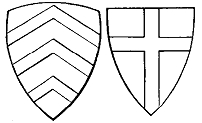
Left: arms of Gilbert de Clare, Earl
of
Gloucester and Hertford; or, three
chevrons gules.
Right: arms of Roger le Bigod, Earl
of Norfolk; or, a cross gules.
most likely to have arms, and a man with
many retainers, even a merchant or other
non-adventurer, is more likely to require arms than is a lone magic-user
or
thief. Possession of arms is considered
to be a prerogative of a gentleman, so
a
thief or other person living on the fringes
of acceptable society is not likely to
bear
arms.
In chaotic areas, duplication of arms
might be common, even deliberate. Many
leaders might not bear arms at all, preferring
some other method of identification such as a distinctive style of armor
or helmet.
In any area where infantry rather than
cavalry dominates the armed forces,
coats of arms could be less commonly
used. Of course, flags can incorporate
coats of arms, but they can also represent
nations rather than individual lords.
Where only the arms are used for identification,
it is possible to impersonate an
individual or pretend to be a group of
retainers of some lord. There are many
opportunities to make armory and heraldry
a part of the game if the DM is
willing to do the necessary groundwork.
The descriptions and definitions below
are merely an introduction; in order to
understand armory better, the reader
should consult reference works such as
those listed in the bibliography.
An “achievement of arms” or “armorial
bearings” consists of several elements
—the crest, helm, supporters, mantling,
and shield. But for the original purpose
(identification) only a patterned shield
was used, and this is the only element
this article will describe.
Armory uses a special language, descended
from French and Old English, to
describe the pattern of arms. While the
details can become complex, the objective
was to describe the pattern briefly,
elegantly, and uniquely, however strange
the words may sound today. As the elements
of the patterns are discussed,
some of the words needed to blazon, or
describe, the arms will be introduced.
Only nine contrasting tinctures
are
used on a shield, divided into five colors,
two metals, and two furs.
For practical
use, the metals can be considered two
additional colors, while the furs are
patterns of two other tinctures. The colors
are black (sable), red (gules),
blue
(azure), green (vert), and
purple (purpure). In England, orange-brown (tenne)
and sanguine (murry) are occasionally
used, but they are regarded as tainted
colors indicating illegitimacy
or other
fault or flaw in the bearer’s ancestry.
The metals are gold (or), usually
represented as yellow, and silver (argent),
usually shown as white.
The rarely used furs are ermine
and
vair. Ermine is an argent background
covered by regularly spaced black marks,
which consist of an arrowhead surmounted
by three small dots, one just
above the point and one to either side
and slightly lower. This “fur” derives
from the fur of the arctic stoat (ermine),
which, used as the lining of cloaks, became
a symbol of rank and office. Vair
(from an unusual squirrel fur) is represented
by rows of bell shapes, the argent
upside down and the other tincture (usually
azure) right side up so that the two
rows fit together alternately; four sets
cover the shield.
The first element of the blazon
(description) is the tincture of the shield as a
whole, the field. Occasionally
the field
may be a pattern of small objects, similar
in effect to one of the furs. Next comes
the charge, describing the object
placed
over the field. Sometimes a party field
(a
field of two tinctures used in roughly
equal amounts) is used without a basic
charge.
The field and charge alone are enough
to construct many distinctive patterns,
but most arms include elaborations of
the charge. These include heraldic animals,
crosses, towers, abstract shapes,
common beasts — virtually anything the
originator of the arms desires.
Arms may be differenced and marshalled
as well, to indicate marriage alliances, sons, bastardy, and the like.
Differencing and marshalling can be a complicated subject, and should be
pursued
further only by those readers who are
sufficiently interested.
Anatomy of the
field
The rule of armory is that no color
should be placed on a color and no metal
on a metal. For example, a gold charge
may be placed on a blue background (or
vice versa), but a gold charge should
not
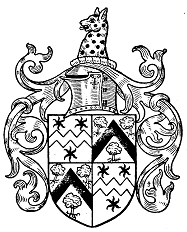
Armorial bearings of John Comber, Esq.:
Arms described as quarterly, 1 and
4, or,
a fess dancette’ gules, between three
estoiles sable; 2 and 3, argent, a chevron
sable, between three thorntrees proper.
be placed on a silver background. This
rule was adopted to heighten contrast
and improve visibility at a distance.
It is
done, however, and whether the rule
should be enforced (and how) must be
left to each DM.
The parts of the field are named in the
language of armory as follows. The left
side or flank as one looks at the
shield is
the dexter, the right side the
sinister.
(These latter terms derive from the Latin
for right and left, respectively, but
this is
from the viewpoint of someone behind
the shield, the one holding it.)
The chief is the top third of the
field;
the fess is the middle third; and
the base
is the bottom third. The blazon for a
red
shield with a white top third, then, is
“gules, a chief argent.”
The parts of the shield which comprise
the basic charges are also known as ordinaries.
There are other ordinaries besides the chief, fess and base which do
not so easily correspond to parts of the
field. A pale is a broad vertical
line running from the top to bottom of the shield
through the middle. A chevron is
an inverted “V” not quite reaching the top of
the shield, but entering the chief at
its
point. The bend is a diagonal bar
running from upper left to lower right. A
saltire is a narrower bend plus
a bend
sinister — that is, a bend running from
lower left to upper right; the entire
design looks like an “X.”.
The lines followed by the ordinaries
may be used to divide the shield per
party. For example, per party saltire (or just
per saltire) is a shield divided into
four
quarters by an “X.” A shield divided by
a
cross would be quarterly. There
are many
variations on these basic patterns, such
as bendy (several narrow bends
parallel
to each other), a chief indented
(with a
sawtooth-like boundary rather than a
straight-line boundary), or a cross wavy
(with a wavy rather than a straight outline),
or bordure (a narrow border all
around the field).
Thus, a shield “per pale gules and
azure a chevron or, a bordure sable”
is
red on the left, blue on the right, with
an
inverted yellow V over the colors of the
field and a black border around the
shield. A book
of heraldry will describe
many other combinations.
Charges: decoration and identification
The primary charges on the field can
be virtually anything. There are conventional
drawings (and special names) for
the more common charges, as well as a
language for describing how the charge
is arranged when there can be doubt. For
example, it is not enough to say where
an
animal is on the shield; its facing and
attitude must also be stated to avoid
ambiguity.
When a man assumed arms, he often
chose charges symbolic of himself or his
family. The less solemn might make a
play on words, such as the family of Catt,
Catton, or Keats using a cat as a charge.
William Shakespeare’s arms showed a
hand grasping several spears.
An animal
related to the location or nature of his
estates, such as a fish for an islanddwelling
knight, might be preferred.
The more serious or idealistic might
choose symbols to emphasize their
courage or good fortune. Thus the lion,
symbol of valor, was a favorite charge,
and the dragon likewise. Religious piety
could be expressed in the arms. The
Christian (Latin) cross is the classic
means, but a special cross of Calvary,
angels, or other religious symbols might
be used.
A list of some types of popular charges
includes: divine beings, humans, lions,
deer (stag, hind, etc.), felines (cat,
panther, Bengal tiger, etc.), bears, elephants,
camels, birds, fish, insects, monster
(dragons, wyverns, unicorns, griffons,
etc.), celestial objects (sun, moon, stars
[“etoiles”], clouds), trees, plants,
flowers
(fleur-de-lis, rose, etc.), and certain
inanimate objects (castle, five-pointed star
[“mullet”], caltrop, whirlpool,
galley,
sword). When a charge is presented in
its
natural color, the blazon is said to be
“proper.”
Four-legged animals are frequently
used as charges. The common attitudes
are defined below. (Generally, the tail
is
erect.)
Rampant (as “a lion rampant”): Animal
stands on one hind leg with three legs
in
the air at different angles.
Passant: Three legs are on the ground
with the dexter foreleg raised to head
height. The tail curves over the back.
Salient: Leaping, but with both
hind
legs still on the ground. (The “ground”
the animal stands on is never shown, of
course.)
Statant: As passant, but with all
four
legs on the ground.
Sejant: Seated on hindquarters with
all
legs on the ground. (Sejant erect: Front
paws are high in the air at different
angles.)
Couchant: Legs and belly are on
the
ground but head and tail are held high,
the tail first passing between the legs.
Dormant: As couchant, but with head
down and tail on the ground —sleeping,
in effect.
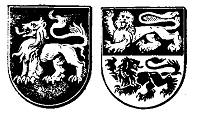
Lion statant (left), lion passant guardant
(top right), and lion passant regardant
(bottom right).
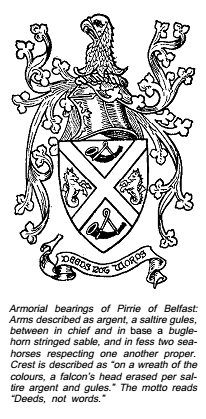
Armorial bearings of Pirrie of Belfast:
Arms described as argent, a saltire
gules,
between in chief and in base a buglehorn
stringed sable, and in fess two seahorses respecting one another proper.
Crest is described as “on a wreath
of the
colours, a falcon’s head erased per
saltire argent and gules.” The motto reads
“Deeds, not words.”
In all positions the animal faces to the
dexter. Other terms (below) describe the
head position. Unless one of these is
used, the head also faces to the dexter.
Guardant: Head faces the person
looking at the shield.
Reguardant: Head looks backward
over the animal’s shoulder.
An animal “sinister” (as in “Lion passant
guardant sinister”) faces the right
side of the shield as we look at it.
Blazoning is fairly simple once you
pick up some of the vocabulary. After
reading just a few paragraphs, you know
what that strange concoction, “a lion
rampant guardant or,” means. Boutell’s
Heraldry (see bibiliography)
gives descriptions of all the terms you’ll ever
want to look up.
The use of arms in
gaming
There are a myriad of ways for the DM
to incorporate the use of armory in the
campaign. Three general suggestions
are given below, and should cause other
possibilities to come to mind.
First, a player who possesses arms
hears of or meets a non-player
character
with similar arms. Is this an honest mistake,
or is the NPC trying to deceive others? The player character can hardly
ignore the situation — he’ll have to investigate further.
Second, some non-player character
accuses a player character of stealing
the accuser’s armorial bearings. A challenge
to combat or an appeal to the high
court may result. The accusation may be
only a means to some dark end.
Third, in order to accomplish some
goal the player desires — for example,
marriage to a noble’s daughter, he must
earn arms from the King. This means he
must visit the King (a wilderness adventure
in itself) to discover what he can do
to earn arms, and then he’ll have to accomplish
that task.
Bibliography
Dozens of books about heraldry have
been published in the past twenty years.
In general, one is better off avoiding
the
older books, especially those of the last
century.
J. P. Brooke-Little, ed., Boutell’s
Heraldry
L. G. Pine, Teach Yourself Heraldry
Charles MacKinnion, Observers Book
of Heraldry
(Editor’s note: Illustrations for this
article, and the descriptions accompanying those illustrations, were taken
from
“The Art of Heraldry” by Arthur
Charles
Fox-Davies, published in 1976 by Arno
Press, New York. Readers are referred
to
that book or a similar reference work
for
definitions of terms mentioned in the
captions which are not included in
the
author’s text. There are far too many
specific terms used in armory and heraldry
for an article of this scope to be
able to cover them all. The meaning
of
many of the terms can be figured out
by
matching the elements of a description
with its accompanying picture.)
Of course, the best place to start is the
encyclopedia. Most heraldry books will
tell you far more than you’ll ever want
to
know; an encyclopedia gives you a more
manageable dose.
(Editor’s note: Examples of the use
of
heraldry in fantasy role-playing may
be
found in THE WORLD OF GREYHAWK™
fantasy world setting by Gary Gygax
[produced by TSR Hobbies, Inc.].
The front and back covers of this playing
aid are crowded with full-color arms
for the various nations described within.
Some traditional heraldic rules such
as
color combinations are broken, but
this
is in the name of artistic license
to produce a better-looking product.
Many of the arms were designed to
correspond to the factions they represented:
The arms of the Free City of
Greyhawk have a broken chain over a
wailed city; the Orcs of the Pomarj
have a
grinning skull; the Hold of Stonefist
—
you guessed it, a stone fist.
A total of 78 arms are depicted, and
there is a brief discussion on orders
of
knighthood and how they may conflict
and compete in a fantasy world setting.)
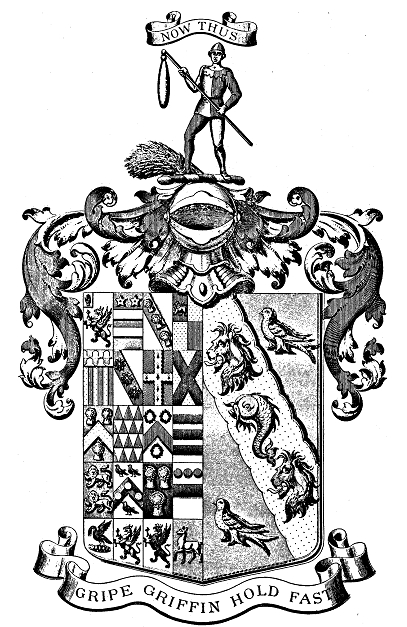
This reproduction of the armorial bearings
of Sir Humphrey Francis de Trafford
illustrates how complex an armory design
could be. The elements of the arms are
described as follows: Quarterly of
twenty, 1. argent, a griffin segreant gules; 2. argent,
two bears, and in chief two mullets
pierced azure; 3. argent, on a bend azure, three
garbs proper; 4. quarterly, gules and
or, in the first quarter a lion passant argent; 5.
paly of six argent and gules, a chief
vaire; 6. argent, on a bend gules, three escarbuncles sable; 7. vert, a
cross engrailed ermine; 8. or, a saltire sable; 9. azure, a chevron
argent, between three garbs proper;
10. bendy barry gules and argent; 11. argent, a
chevron gules, between three chaplets;
12. argent, three bars sable; 13. gules, two
lions passant guardant in pale argent;
14. argent, on a chevron quarterly gules and
sable, between three birds of the second
as many bezants; 15. argent, three garbs
proper, banded or; 16. argent, a fess
sable, in chief three torteaux; 17. argent on a child
proper, wrapped in swaddling clothes
gules, and banded or, an eagle sable; 18. argent,
a griffin segreant azure; 19. argent,
a griffin segreant sable, ducally crowned or; 20.
azure, a hind trippant argent, and
impaling the arms of Franklin, namely: azure, on a
bend invected between two martlets
or, a dolphin naiant between two lions’ heads
erased of the field.
Heraldry hints
To the editor:
In the September 1981 issue of DRAGON
magazine, Lewis Pulsipher has written a generally
good article giving a brief introduction
to armory. (I tend to disagree with him that
“heraldry” should not be used, since the principal
duty of heralds has been to keep coats of
arms straight [“Or, a fess checky argent and
azure, within a tessure fleury-counterfleury
gules? That’s Sir Robert Stuart, uncle to the
King of Scotland, my lord.“], and anyway, heraldry
is, rightly or wrongly, the generally accepted
term.) There are a couple of things I
would like to add.
First, while the fact that there are two different
kinds of tinctures, the metals and the colors,
is mentioned, Mr. Pulsipher gives the
impression that there is no real difference between
them. There is a difference, and while it
is not very important in an AD&D
game, where
you are working with figures a couple of feet
away, it is important on a battlefield. One of
the first rules of heraldry is: Do not put a metal
on a metal or a color on a color. The reason is
that such a combination does not show up
very well at a distance. (Try reading, for example,
red printing on blue paper.)
There are other furs than just ermine and
vair. (Incidentally, the word vair [a squirrel
skin] is responsible for one of the great misconceptions
in literature. When Charles Perrault
wrote Cinderella, he described her footgear
as “peds du vair,” or squirrel-skin slippers.
In the English translation, this became
“peds du verre” — glass slippers.) The other
ermine (black tails on a white background;
note the color-on-metal combination) based
furs include ermines (also called contre-ermine),
white tails on black; erminois, black
tails on gold; and pean, gold tails on black.
The vair variants include different shapes and
arrangements of the bells, and other tinctures
than the standard blue and white.
There are many different charges that one
can put on a shield (the term “coat of arms”
refers specifically to a surcoat worn over the
armor, but the usual depiction of a coat of
arms is on a shield), and many variations on a
theme — Fox-Davies, I believe, has examples
of over two dozen different kinds of crosses.
In addition to the books Mr. Pulsipher mentions,
I also recommend Simple Heralrdy by
Ian Montcrieffe and Don Pottinger. The main
advantage of this book is that all the illustrations
are in color.
John A. Hobson
Bolingbrook, III
(Dragon #56)